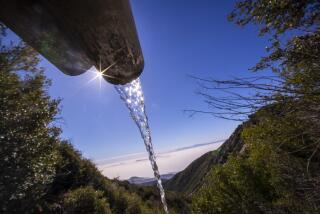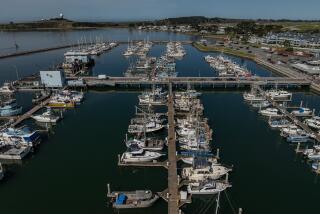Tiny snail in peril as Idaho hot springs dry up
- Share via
BRUNEAU, IDAHO — After clambering down a canyon wall, ducking poison ivy vines along a switchback trail and wading chest-deep across a lukewarm stream, Cary Myler squats down near a riverbank, spies some flecks that look like pepper sprinkled on a wet rock and announces: “Found some.”
The pinhead-sized dots are Bruneau hot springsnails. The tiny mollusks that thrive in water as warm as 100 degrees are found nowhere in the world but here, in the bottom of this desert canyon riddled with hot springs 70 miles southeast of Boise.
A decade ago, the snails were at the center of a national battle over federal laws designed to protect endangered species. Today, years after the lawsuits were decided and most of the rhetoric retired, they are closer to extinction than ever.
That’s because the level of the underground geothermal aquifer that feeds the seeps and springs of hot water where the snails live keeps dropping. Rock faces where films of hot water harbored thousands of the tiny algae-eating snails a few years ago are now dry and bare.
Some blame the decline in the aquifer on drought. Others, including the U.S. Fish and Wildlife Service, suspect the primary cause is groundwater pumping of the hot water to irrigate surrounding farmland.
Congress appropriated $1 million six years ago for Bruneau Valley farmers to switch from flood irrigation to more efficient sprinkler pivots. Meanwhile, cropland that had lain fallow for years under a federal conservation reserve program was put back into production.
The amount of groundwater pumped from beneath the Bruneau Valley to irrigate the fields has increased to nearly 10,000 acre-feet annually, almost double what it was in 1995.
“We’ve put $1 million into pivots and we’re still seeing a decline in the aquifer,” said Myler, a Fish and Wildlife Service biologist who’s now preparing a five-year status report on whether the snail deserves to remain on the federal government’s list of endangered species. “More water is being pumped now than it was when the snail was listed, and we’re finding fewer hot springs every year.”
First collected in this remote stretch along the Bruneau River in 1952, the Bruneau hot springsnail was originally proposed for inclusion on the endangered species list in 1985 after the agency documented a steady drop in the aquifer.
That triggered a pitched legal battle over just how far the Endangered Species Act should go in preventing human activities that might jeopardize the survival of a creature the size of a poppy seed. The snail became a cause celebre of the Sagebrush Rebellion, a symbol of government regulation run amok.
The local Farm Bureau, Owyhee County and the Owyhee Cattlemen’s Assn. sued in 1993 to stop the listing, fearing it would drive family farms to extinction. Idaho’s U.S. Senate delegation threatened to withhold funding for all endangered species if the Fish and Wildlife Service didn’t back off on plans to list the microdot mollusk.
Even former President Richard Nixon, who had signed the Endangered Species Act into law in 1973, wrote in a book shortly before his 1994 death that “measures designed to protect endangered species such as bears, wolves and bald eagles are now being used to force Idaho farmers off their land for the sake of the thumbnail-size Bruneau hot springsnail.”
Conservationists sued to force the listing, arguing that politics was manipulating the scientific determination of whether the snail faced extinction.
The Fish and Wildlife Service, over the objections of the state of Idaho, listed the snail as endangered in 1993. Later that year, a federal judge in Idaho ruled that the agency had abused its discretion and removed the snail from the list -- the first time an endangered species had been delisted by court order rather than scientific evidence of recovery. But the U.S. 9th Circuit Court of Appeals reversed the ruling and restored the snail to the list, where it has been since 1998.
The service has argued that the Bruneau hot springsnail is a classic canary-in-the-mineshaft species.
“The snail is the messenger telling us that a water problem exists and must be dealt with or the ecosystem and agriculture upon which human beings depend will continue to crumble,” Mollie Beattie, the director of the agency at the time, told the National Press Club in 1993. “Once again, the local reaction is quite literally to kill the messenger rather than heed the message.”
Today, as the agency prepares a status report on the snail’s future in the face of a continually declining aquifer, some veterans of the snail wars are bracing for the next round.
“Nobody is taking a swing at anybody yet, but we all wonder how low does that water have to go before the Fish and Wildlife Service must step in and take that first swing?” said Quey Johns, a Bruneau farmer who was president of the Farm Bureau when it sued the government over the listing. “The water hasn’t run out, and we are going to keep going until there isn’t any more. That’s just the way you farm.”
The agency and the Idaho Department of Water Resources have proposed an experiment to see if reducing the pumping of irrigation water would raise the aquifer level.
The owner of one of the major irrigation wells in the area, agribusiness giant JR Simplot Co., would be paid $19,000 by the Fish and Wildlife Service to stop pumping for one growing season starting in March.
The two agencies would then monitor the aquifer level from six surrounding wells to see if turning off the pump stops the drop. Simplot officials have yet to agree to the proposal.
“It’s the pumping that’s causing the decline, but we don’t have a lot of money to work with in solving it,” said Shane Bendixon of the Idaho Department of Water Resources.
Johns said if shutting off the Simplot pump raises the aquifer level and resurrects some of the dried-out hot springs where the snails live, the fight over farming’s future in the Bruneau Valley may be renewed.
“I just wish I knew if that snail was really this important, that it maybe does have something in it that will help us cure cancer or something,” he said.
“If this snail really benefits everyone in the U.S., then maybe everyone in the U.S. ought to pay those of us here who are going to get hammered by it.”
More to Read
Sign up for Essential California
The most important California stories and recommendations in your inbox every morning.
You may occasionally receive promotional content from the Los Angeles Times.










